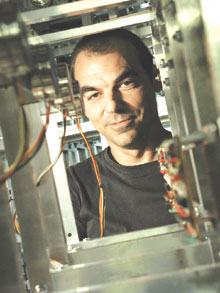Hexagram has big dreams, new boss

Bill Vorn, aka Professor Yves Bilodeau, is Scientific Co-Director of Hexagram.
The top two floors of the new fine arts and engineering complex under construction at Guy and Ste. Catherine Sts. will soon be equipped with high-tech machinery including a computerized loom, an industrial robotic arm, and high-definition cameras.
Shopping for these items, to be used in digital and multimedia art, is now under way in the name of Hexagram, the upstart Institute for Research and Creation in Media Arts and Technologies created jointly by Concordia and the Université du Québec à Montréal.
Hexagram was awarded a grant of $21.9 million from the Canadian Foundation for Innovation two years ago. About $8 million of that money is being spent on Hexagram’s new facilities on the top floors of the new building, and in its basement.
The $10 million equipment portion of the grant is being shared about equally between Concordia and UQÀM, said Bill Vorn, Scientific Co-Director of Hexagram and Concordia’s representative in the institute’s administrative triumvirate.
“We will be moving into the new building with very sophisticated equipment,” said Vorn, who currently works on a robotic installation in a temporary Hexagram space on Ste. Catherine St., a few blocks west of Concordia’s downtown campus.
For instance, the robotic arm will be used by Hexagram’s artist-researchers to “experiment with precision robotics,” he said. “It will be very precise and strong and fast.”
In addition, the computerized loom will be available to artists working with textiles and “digital wearables,” including Concordia Fine Arts professors Barbara Layne, Ingrid Bachmann, and Joey Berzowska. This machine will be imported from France.
The first installment of the grant money to pay for the equipment was received recently after the two universities fleshed out an agreement on which institution would receive funds for which machines, Vorn explained.
That process was managed by Hexagram’s new director, Alban Asselin, an experienced administrator with a corporate background in Quebec. He has brought crucial management skills to Hexagram, needed to foster co-operation between the two founding institutions as well as with outside partners in the private and public sectors.
Under Asselin’s leadership, Hexagram will be looking to build further partnerships in the worlds of arts, engineering and computer science. For instance, Hexagram has been in contact with Cirque du Soleil, the Museum of Civilization in Quebec, and software companies.
Things will start to fall into place for Hexagram once it occupies the new facility, probably by the spring of 2005, Vorn predicted. “We’ll have an official face, and that’s going to help us a lot.”
One of the main features of Hexagram’s facilities in the Fine Arts and Engineering complex will be a so-called black box in the basement of the new building, a space that can be used for installation and performance projects, as well as cinema and video shoots.
Modeled on a room in the Montreal Museum of Contemporary Art, the black box will enable researchers to experiment with projects that involve using a large space.
“We’re trying to make the space as flexible as possible, to accommodate many different applications, from hanging things to running cables under the floor,” Vorn said.
In a unique twist, the facility will be linked by high speed internet to a similar black box at UQAM, allowing for some potentially pioneering experiments. In a hypothetical example, dancers wearing motion sensors in one space could have their gear linked up to computers in the other in order to generate virtual or robotic dancers.
“It’s difficult to predict the projects,” said Vorn, adding that Hexagram’s potential will become more apparent once its facilities are up and running. “Interesting experiments will start to happen.”